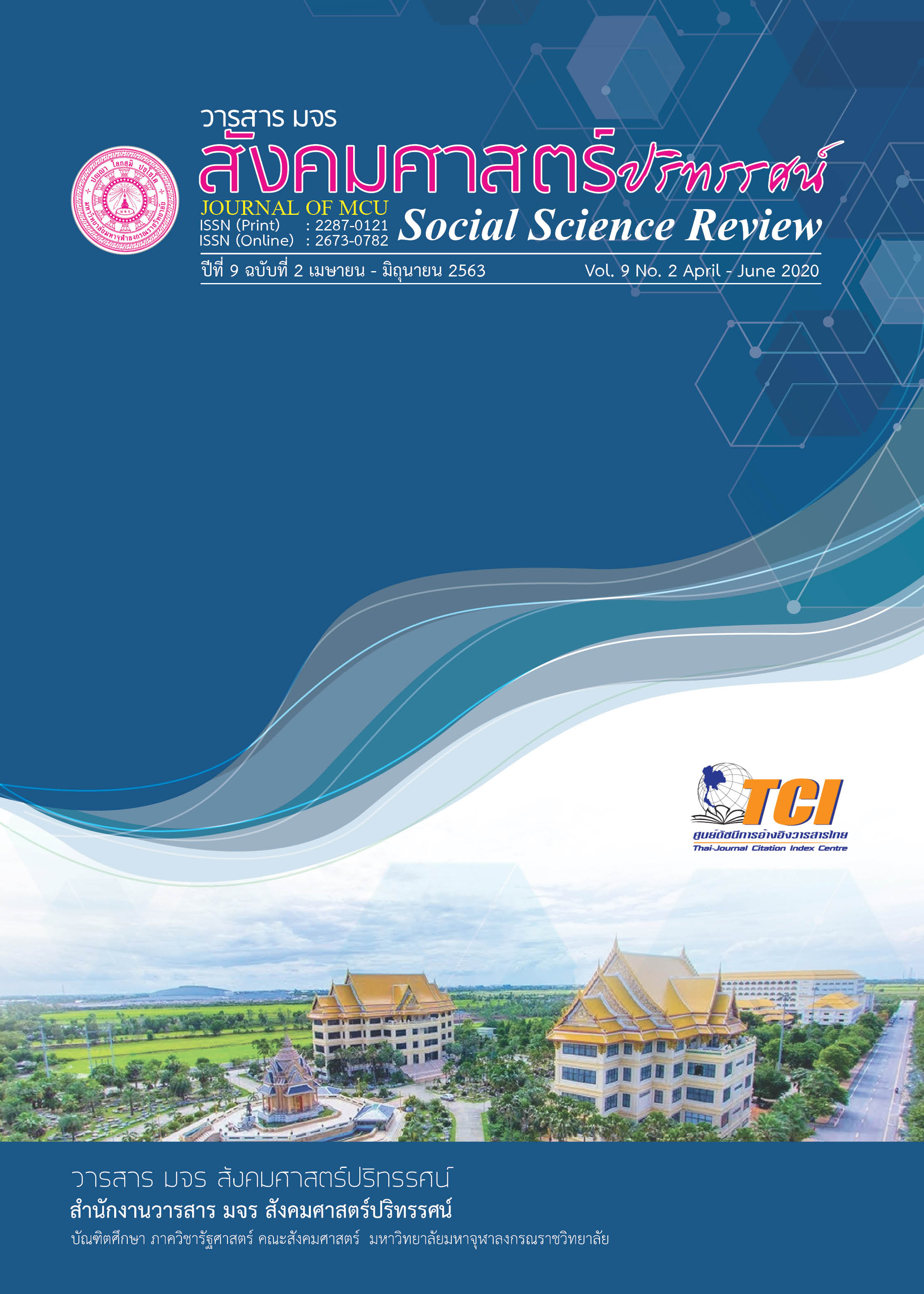การศึกษาต้นทุนโลจิสติกส์และโซ่อุปทานแห้วในเขตตำบลวังยาง อำเภอศรีประจันต์ จังหวัดสุพรรณบุรี
คำสำคัญ:
การปลูกแห้ว, ต้นทุนโลจิสติกส์และโซ่อุปทานต้นทุนด้านบริหารจัดการ, ต้นทุนด้านการจัดหาและต้นทุนทางด้านการขนส่งบทคัดย่อ
การศึกษาครั้งนี้มีวัตถุประสงค์เพื่อศึกษาต้นทุนโลจิสติกส์และโซ่อุปทานแห้ว และเพื่อศึกษาแนวทางในการปรับปรุงต้นทุนโลจิสติกส์และโซ่อุปทานแห้ว ในเขตตำบลวังยาง อำเภอศรีประจันต์ จังหวัดสุพรรณบุรี เป็นการวิจัยแบบผสานวิธีเก็บข้อมูลจากเกษตรกรผู้จำหน่วยผลผลิตจากแห้ว 258 ราย สถิติที่ใช้ในการวิเคราะห์ข้อมูล ได้แก่ ค่าความถี่ ร้อยละ ค่าเฉลี่ย และส่วนเบี่ยงเบนมาตรฐาน และในส่วนของงานวิจัยเชิงคุณภาพใช้แบบสัมภาษณ์เป็นเครื่องมือในการวิจัย เก็บข้อมูลจากผู้จัดหาแห้วและผู้จัดจำหน่ายในเขตตำบลวังยาง จำนวน 9 ราย วิเคราะห์ข้อมูลแบบอุปนัย ผลการวิจัยพบว่า 1) เกษตรกรมีความคิดเห็นเกี่ยวกับต้นทุนโลจิสติกส์และโซ่อุปทานด้านบริหารจัดการ ต้นทุนด้านการจัดหา และต้นทุนทางด้านการขนส่งในภาพรวมอยู่ในระดับมาก 2) ระดับต้นน้ำ กลุ่มของผู้ผลิตและแปรรูปแห้วต้องการให้เกิดการพัฒนาในเรื่องพื้นที่ปลูกแห้วและสายพันธุ์ ซึ่งพื้นที่มีการใช้สารเคมีทำให้ดินเสื่อมสภาพ สายพันธุ์แห้วที่ปลูกต้องซื้อเมล็ดพันธ์จากประเทศจีน และยังไม่มีการพัฒนาสายพันธุ์ของไทย ทำให้การขายหัวสดจะได้ราคาต่ำ ซึ่งชาวนาต้องการราคาเพิ่มขึ้นอีก กิโลละ 2-3 บาท 3) ระดับกลางน้ำ: กระบวนการเริ่มจากการขายแห้วดิบต้องมีการปอกเปลือกซึ่งต้องใช้แรงงานคนทำให้มีต้นทุนสูงประกอบกับขั้นตอนการฟอกสี ก่อนเข้าโรงงานทำให้เกิดมลพิษสะสมในดิน และ 4) ระดับปลายน้ำ: ผลิตภัณฑ์แห้วยังไม่เป็นที่รู้จัก โดยเฉพาะในกลุ่มของคนรุ่นใหม่ การแปรรูปมีปริมาณน้อย และความต้องการของตลาดต่ำ แต่ถือว่าได้ความเป็นเอกลักษณ์ของพื้นที่
เอกสารอ้างอิง
กมลชนก สุทธิวาทนฤพุฒิ. (2547). การจัดการโซ่อุปทานและโลจิสติกส์. กรุงเทพฯ: สํานักพิมพ์ท๊อป/แมคกรอ-ฮิล.
กัลยา วานิชย์บัญชา. (2550). การวิเคราะห์สถิติ: สถิติสําหรับบริหารและวิจัย (พิมพ์ครั้งที่ 10). กรุงเทพฯ: โรงพิมพ์จุฬาลงกรณ์มหาวิทยาลัย.
ธัญญธร ศรีวิเชียร. (2560). ผลกระทบของการบริหารต้นทุนเป้าหมายที่มีต่อความได้เปรียบทางการ แข่งขันและผลการดำเนินงานของอุตสาหกรรมอาหารในประเทศไทย. วารสารมนุษยศาสตร์และสังคมศาสตร์ มหาวิทยาลัยมหาสารคาม, 36(6), 203-217.
เริงศักดิ์ กระจ่างจันทร์. (2549). การจัดการโลจิสติกส์ของผู้ประกอบการธุรกิจโรงสีข้าวในเขตจังหวัดร้อยเอ็ด (การค้นคว้าแบบอิสระปริญญาบริหารธุรกิจมหาบัณฑิต สาขาวิชาการจัดการเชิงกลยุทธ์). มหาสารคาม: มหาวิทยาลัยมหาสารคาม.
สนั่น เถาชารีและระพีพันธ์ ปิตาคะโส. (2555). การจัดการโลจิสติกส์และโซ่อุปทานข้าวในภาคตะวันออกเฉียงเหนือของประเทศไทย. วารสารวิจัยมหาวิทยาลัยขอนแก่น, 17(1), 125.
สำนักงานเกษตรอำเภอศรีประจันต์. (2559). ข้อมูลการผลิตแห้วจีน. สืบค้น 15 ธันวาคม 2559, จาก http://sriprachan.suphanburi.doae.go.th/
สำนักงานเศรษฐกิจการเกษตร. (2560). ข้อมูลเศรษฐกิจการเกษตร. สืบค้น 22 มกราคม 2560, จาก http://www.oae.go.th/view/1/%E0%B8%AB%E0%B8%99%E0%B9%89%E0%B8%B2%E0%B9%81%E0%B8%A3%E0%B8%81/ TH-TH
สุธาทิพย์ เลิศวิวัฒน์ชัยพร. (2561). การบริหารจัดการโลจิสติกส์และโซ่อุปทานให้กับเกษตรกรชาวนาแห้ว จังหวัดสุพรรณบุรี (รายงานผลการวิจัย). สุพรรณบุรี: มหาวิทยาลัยเทคโนโลยีราชมงคลสุวรรณภูมิ.
ดาวน์โหลด
เผยแพร่แล้ว
รูปแบบการอ้างอิง
ฉบับ
ประเภทบทความ
สัญญาอนุญาต
ลิขสิทธิ์ (c) 2020 วารสาร มจร สังคมศาสตร์ปริทรรศน์

อนุญาตภายใต้เงื่อนไข Creative Commons Attribution-NonCommercial-NoDerivatives 4.0 International License.
เพื่อให้เป็นไปตามกฎหมายลิขสิทธิ์ ผู้นิพนธ์ทุกท่านต้องลงลายมือชื่อในแบบฟอร์มใบมอบลิขสิทธิ์บทความให้แก่วารสารฯ พร้อมกับบทความต้นฉบับที่ได้แก้ไขครั้งสุดท้าย นอกจากนี้ ผู้นิพนธ์ทุกท่านต้องยืนยันว่าบทความต้นฉบับที่ส่งมาตีพิมพ์นั้น ได้ส่งมาตีพิมพ์เฉพาะในวารสาร มจร สังคมศาสตร์ปริทรรศน์ เพียงแห่งเดียวเท่านั้น หากมีการใช้ภาพหรือตารางหรือเนื้อหาอื่นๆ ของผู้นิพนธ์อื่นที่ปรากฏในสิ่งตีพิมพ์อื่นมาแล้ว ผู้นิพนธ์ต้องขออนุญาตเจ้าของลิขสิทธิ์ก่อน พร้อมทั้งแสดงหนังสือที่ได้รับการยินยอมต่อบรรณาธิการ ก่อนที่บทความจะได้รับการตีพิมพ์ หากไม่เป็นไปตามข้อกำหนดเบื้องต้น ทางวารสารจะถอดบทความของท่านออกโดยไม่มีข้อยกเว้นใดๆ ทั้งสิ้น





